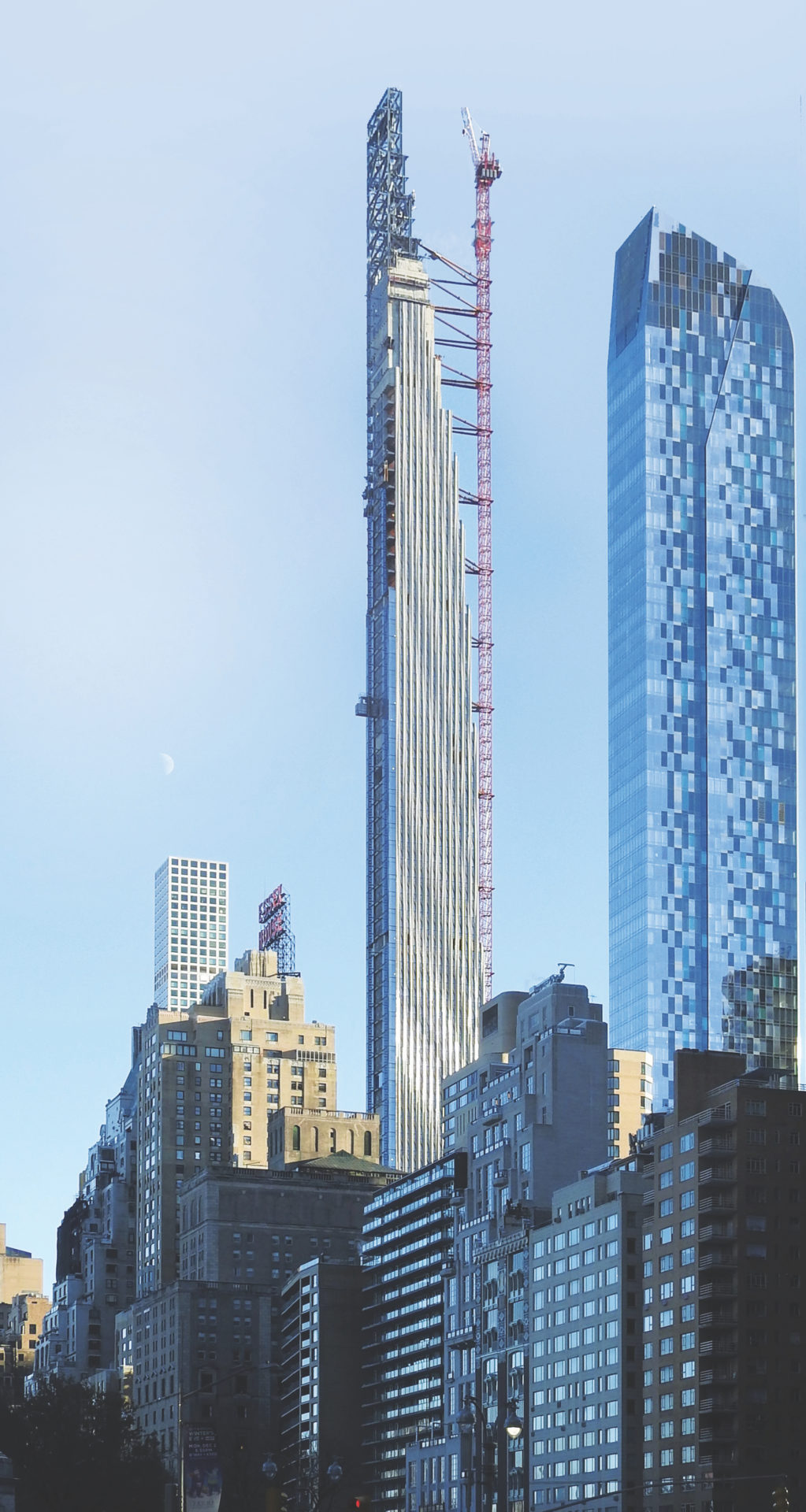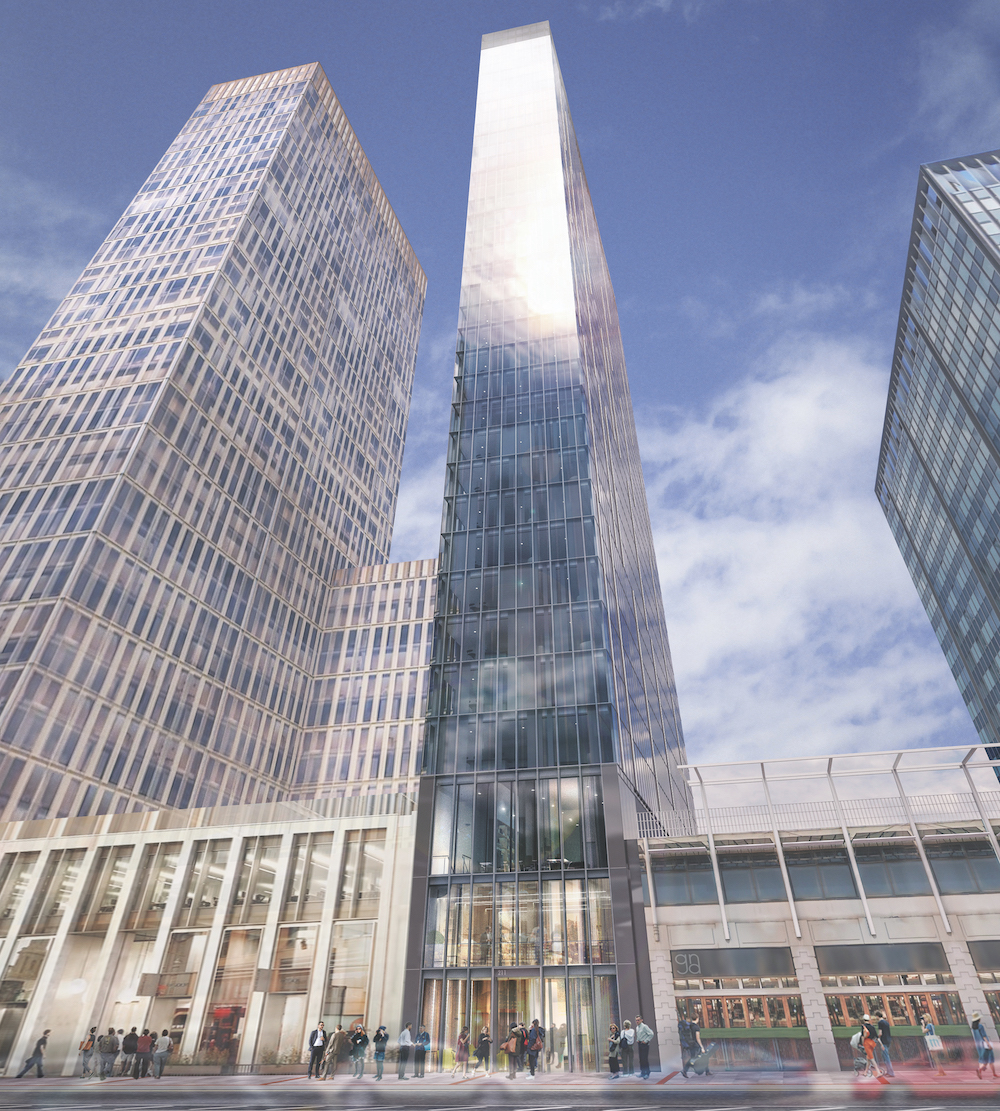
New York, Hong Kong, Melbourne and now…Birmingham? Kristina Smith explores the technology behind the super-slender skyscraper
Last year, Taylor Grange Developments announced that it had obtained planning permission for 211 Broad Street in central Birmingham. What makes this building special is its dimensions. Were it to be built, it would be the UK’s first super-slender skyscraper.
Though plans to start construction on the Birmingham site are paused while the country wrestles with covid-19, across the pond in New York a record-breaking example of this genre is nearing completion: the world’s most slender tower, 111 West 57th Street.
It takes a particular set of circumstances to make these freakishly skinny buildings viable. They come with their own costly engineering and design challenges, which means that only a handful of cities boast them.

The world’s most slender: 111 West 57th Street towers over NYC’s Billionaire’s Row
Rising up like a long exclamation mark to the south of Central Park in New York is 111 West 57th Street. Due to be completed this year, the latest addition to Manhattan’s skyline is the world’s most slender tower with a width-to-height ratio of 1:24 and
a height of 437.5m.
Rising from the site of the historic Steinway Building, which developer JDS Development Group is renovating as part of the project, it sits on the centreline of the park in an area dubbed ‘Billionaire’s Row’ for good reason: of 60 luxury apartments, just nine remained for sale as CM went to press, ranging from $16.5m to $66m.
To provide unrestricted views for its high-rolling residents, and for structural stiffness, engineer WSP designed two 1m-thick shear walls along its east and west sides, made from 100MPa reinforced concrete, with reinforcement and linked to the building’s core. An 800-tonne tuned mass damper near the tower’s tip will limit movement due to the wind, and four floors spread over the height of the buildings are left as voids for the wind to pass through.
Architect SHoP designed this record-breaker, clad in bronze and terracotta, a nod to the Steinway Hall’s art deco design. With the lower floors taken up by a large open atrium, and retail and recreation facilities that include an indoor pool, the building tapers as it rises.
What is slender?
The slenderness of a building is expressed as the ratio of its width to its height. “Any building with a slenderness ratio greater than 1:10 is considered slender, with very slender buildings having ratios of 12 to 15 and even more,” explains Giorgio Bianchi, a director at engineer Robert Bird.
Birmingham’s 211 Broad Street would have a slenderness ratio of 1:12. Manhattan’s 111 West 57th Street’s ratio is a waif-like 1:24.
The reason to construct such unusual buildings comes down to one thing: land values. When the market price of apartments is high enough to pay for the complexity, developers and investors are interested. Super-slenders are always residential, usually with one apartment per floor; commercial buildings would require bigger cores, eating up too much of the precious floor space.
Hong Kong was the first city to construct slender towers in the 1970s. Today it boasts multiple super-slender buildings and can claim the highest concentration of such structures in the world. Until 111 West 57th Street took its crown, Highcliff in Hong Kong, completed in 2003, was the world’s most slender at 1:20.
In New York, a crop of super-slender towers has sprung up in the city’s Midtown. A quirk in development rights allows New York developers to reach for the skies by combining air rights from neighbouring plots.
After the 2008 global financial downturn, super-rich investors wanted to put their money into these luxurious residential properties with views across Central Park and the city. The sales website for 111 West 57th Street is available in Spanish, German, Russian, Chinese and Arabic.
Aside from Hong Kong and New York, Melbourne has the beginnings of a super-slender collection. Phoenix Apartments, for which Robert Bird was the structural engineer, completed in 2014, has a slenderness ratio of 13.5 to 1 although it is just 88.5m high. Collins House, completed in 2019, is 190m tall with a slenderness ratio of 16.5 to 1.

Super-slender in Brum: 211 Broad Street faces tight site challenges
Plans for a super-slender tower at 211 Broad Street in Birmingham were largely down to the size of the plot, says Lisa Deering, director at Glancy Nicholls Architects, which designed the building.
“Further to this, it is located on one of the busiest and most dynamic streets in Birmingham, opposite a key junction and the new Metro line,” says Deering. “Located in an area designated for high-rise developments, the site provided a key opportunity
to design a landmark building unlike anything else within the city.”
Unlike its much taller cousins in New York, at 116.5m tall, 211 Broad Street doesn’t require a damper or voids to reduce the wind load, although the prevailing wind on the longer elevations will cause the building to twist. To resist these forces, engineer Design2e has designed a three-storey-high concrete ‘tube’, supported on continuous pile walls down each long side and braced by stiffened floor plates at the first and second floor and connections to the core.
“The very torsional stiff tube spreads the larger very significant overturning base moment, which is characteristic of tall buildings, relatively evenly along the complete length of the building,” says Design2e managing director Dave Tyson. “The overturning base moment is resisted with a push-pull action shared across the piled foundations.”
Should construction go ahead – United Living is understood to be the contractor – the challenges will be all those that a tight city site offers and then some. One possibility that Glancy Nicholls has investigated is the use of a monorail system for installing the unitised facade.
“This would move up the building as floor plates were completed, providing a quick, effective and safe method for installing the facade with no impact on the neighbouring properties,” says Deering.
Fooling the wind
Super-slender skyscrapers invariably have concrete frames for several reasons: increased stiffness, improved acoustic properties and the ability to provide longer column-free spans; owners of luxury high-rise apartments don’t want their expensive views obstructed.
For super-slender towers it is common to use high-strength concrete, usually between 60MPa and 100MPa compressive strength, sometimes even higher, allowing the structural members to be slimmer. High-strength concrete has a lower water-to-cement ratio, containing pozzolans such as fly ash or silica fume. Advances in admixtures – superplasticizers and retarders – which allow the mixes to remain workable and pumpable with low water content, have enabled the rise in strength.
“In addition to high strength, these concretes also have a high modulus of elasticity which increases the stiffness of the concrete elements,” explains WSP’s building and property managing director Kamran Moazami.
Wind is the biggest challenge for designers. When air hits the building, vortices are shed on alternate side of the building, creating a buffeting effect known as vortex shedding.
The top of a skyscraper can move by several hundred millimetres, says Bianchi: “This is perfectly acceptable as long as the accelerations generated by these movements are below the threshold when humans may start to feel motion sickness.” ISO standards set acceleration criteria for wind speeds that might happen once a year, and the Council on Tall Buildings and Urban Habitat (CTBUH) makes recommendations for a 10-year peak.
Structural rigidity alone is not enough to reduce acceleration in the highest floors. Facades may be specially designed with rounded, chamfered or notched corners; some floors may be left open for the wind to pass through; and huge masses or dampers may be installed at the top of the building to slow its acceleration.
Take the 426m-tall 432 Park Avenue in New York, designed by WSP, with a slenderness ratio of 1:15. Its concrete core is linked to a tubular outer frame at five points, with open floors at these points. Additionally, it has a double tuned mass damper at its upper end to reduce wind-induced acceleration.
Getting the combination of voids, dampers and streamlining is no easy matter. “The evaluation of wind-induced accelerations is normally carried out with the support from a specialist wind consultant who performs a wind tunnel test,” explains Bianchi.

Super-slender horizons
Though covid-19 may have temporarily reversed the population flow from rural to urban environments, we may yet see more super-slender towers in cities where land values are high enough. But don’t expect them to get much more slender, says WSP’s Moazami: “The slenderness ratio of 1 to 24 is towards the upper limit of what can be achieved. That takes into account the laws of physics, but also constructability and the economics of the building,” he says.
Melbourne is challenging this statement. A 2018 design competition produced The Magic, a 330m high tower by architect DeciBel with a slenderness ratio of 26.2 to 1. However, for now, The Magic remains an aspiration.
In Birmingham, it is the economics for 211 Broad Street which are challenging. Designed to be an aparthotel, it would require high and immediate occupancy rates – which can’t be guaranteed right now.
“We are waiting for the market,” says Lisa Deering, director at the scheme’s architect Glancy Nicholls of the start-on-site date.
Birmingham – and the UK – may have to wait a little longer for a super-slender debut.










